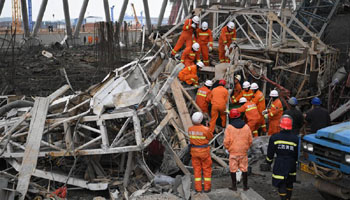WASHINGTON, Nov. 24 (Xinhua) -- Mega-earthquakes -- magnitude 8.5 and stronger -- preferentially occur where faults are mostly flat, a new study said Thursday.
Curvier faults, however, are less likely to experience earthquakes exceeding that strength, according to the study published in the U.S. journal Science.
Mega-earthquakes were long thought to be possible only at the boundary between fast converging, young tectonic plates until two giant earthquakes -- the magnitude 9.1 quake in Sumatra, Indonesia in 2004 and the 9.0 quake in Japan in 2011 -- disconfirmed the theory.
In the new study, U.S. and French researchers showed that the maximum size of earthquakes may be linked to the fault curvature.
"The way people in the science community think about earthquakes is that some fault areas resist failure more than others, and when they break they generate large earthquakes," said lead author Quentin Bletery, a postdoctoral researcher at the University of Oregon.
"The reason they resist failure longer is often debated. I thought variations in fault geometry could be responsible, so I looked for changes in the slope of the major subduction faults of the world."
Bletery and colleagues calculated the slope curvature along the main faults and compared it with the distribution of very large earthquakes that happened in the past.
"What I found is the opposite of what I expected: Very large earthquakes occur on fault areas where the slope is the most regular, or flat," he said.
For example, the Cascadia fault, which last experienced a mega-quake in 1700, lies along such a flat region.
"Earthquakes like the one that happened in Sumatra are mind-bogglingly large," added study co-author Amanda Thomas of the University of Oregon. "The rupture was 1,600 kilometers long. When Cascadia goes, it could be 1,000 kilometers if it ruptures completely."
A key reason is that rupture thresholds are more heterogeneous along curved faults, therefore ruptures distances are restricted by portions of curvy sections that are not ready to fail, they explained.
However, the rupture threshold is more homogeneous along flat faults, allowing larger fault areas to rupture simultaneously.
"The correlation of the curvatures to mega-quakes is strong," Thomas said. "The data don't lie."
Based on the average curvature inside the giant earthquake rupture areas, the researchers concluded that the likelihood that mega-earthquakes are linked to fault curvatures is more than 99 percent.
However, the discovery may not directly help predict when an earthquake will occur.
"Instead, our findings backstop the idea that if you are at a location that hasn't had evidence for large earthquakes in the past and your location is on a curvy plate, then maybe mega-quake will never happen," Rempel said. "Not all subduction zones can have really large earthquakes is the implication of this study."










